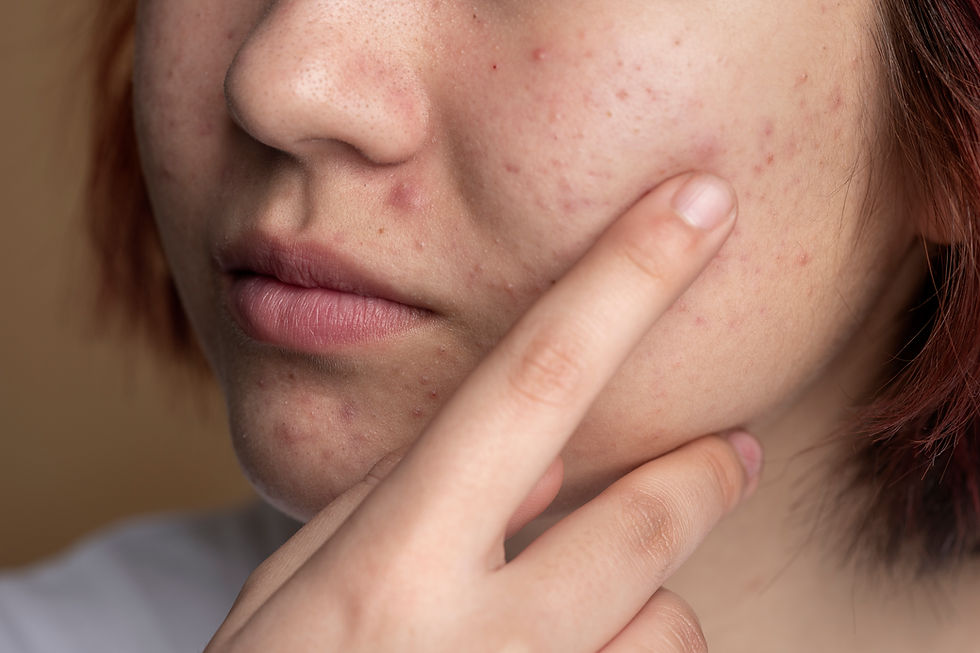Combatting Post-Summer Pigmentation: A Guide to Aesthetic Skin Treatments
- Rosie Osborne
- Aug 8, 2024
- 3 min read

As the cooler months approach, many of us notice unwelcome changes in our skin. Prolonged sun exposure often leaves behind pigmentation issues, including dark spots, uneven skin tone, and hyperpigmentation.
Fortunately, aesthetic treatments offer effective solutions to restore your skin’s natural glow.
Understanding Pigmentation
Pigmentation refers to the coloring of the skin, primarily due to melanin production. Excessive sun exposure can trigger an overproduction of melanin, leading to various pigmentation issues:
Sunspots (Solar Lentigines): Flat, brown spots commonly found on areas frequently exposed to the sun.
Melasma: Larger patches of darkened skin, often caused by hormonal changes and exacerbated by UV exposure.
Post-Inflammatory Hyperpigmentation (PIH): Dark spots that appear after skin inflammation or injury, including acne.
Preventative Measures
It’s essential to remember the importance of prevention and that its much easier to prevent than cure.
Here are some tips to minimise pigmentation:
Sunscreen: Always use a broad-spectrum sunscreen with SPF 30 or higher, even on cloudy days.
Protective Clothing: Wear hats, sunglasses, and protective clothing to shield your skin from UV rays.
Seek Shade: Avoid the sun during peak hours, usually between 10 a.m. and 4 p.m.
Aesthetic Treatments for Pigmentation
Now, let’s explore effective aesthetic treatments to address post-summer pigmentation.
1. Chemical Peels
Chemical peels involve applying a solution to the skin, which exfoliates the outer layers and promotes new skin growth. This treatment can effectively reduce pigmentation and improve overall skin texture.
Types: Glycolic acid, salicylic acid, and TCA (trichloroacetic acid) peels.
Benefits: Diminishes sunspots, melasma, and PIH; enhances skin tone and texture.
2. Laser Treatments
Laser treatments target pigmentation by breaking down melanin deposits in the skin. Different types of lasers are used based on the specific pigmentation issue.
Types: Q-switched lasers, fractional lasers, and intense pulsed light (IPL) therapy.
Benefits: Precise targeting of pigmented areas; minimal downtime; significant improvement in skin clarity.
3. Microneedling
Microneedling involves using fine needles to create micro-injuries in the skin, stimulating collagen production and promoting skin regeneration. It can be particularly effective for PIH and improving overall skin tone.
Types: Traditional microneedling and radiofrequency microneedling.
Benefits: Improves pigmentation, enhances skin texture, and reduces fine lines and scars.
4. Topical Treatments
Topical treatments include creams and serums containing active ingredients that inhibit melanin production and promote skin renewal.
Ingredients: Hydroquinone, retinoids, vitamin C, niacinamide, and alpha arbutin.
Benefits: Gradual reduction of pigmentation; can be used in conjunction with other treatments for enhanced results.
5. Microdermabrasion
Microdermabrasion is a non-invasive procedure that exfoliates the skin using a special device. It helps remove dead skin cells and can reduce the appearance of pigmentation.
Types: Crystal microdermabrasion and diamond-tip microdermabrasion.
Benefits: Smooths skin texture; reduces sunspots and superficial pigmentation; minimal downtime.
Post-Treatment Care
Proper post-treatment care is crucial to maintain results and prevent further pigmentation:
Sun Protection: Continue using sunscreen daily and avoid direct sun exposure.
Gentle Skincare: Use mild cleansers and avoid harsh exfoliants or aggressive skincare products.
Hydration: Keep your skin well-hydrated with moisturizers and hydrating serums.
Follow-Up Treatments: Depending on the treatment, you may need multiple sessions for optimal results.
Conclusion
Post-summer pigmentation can be a challenging skin concern, but with the right aesthetic treatments, you can achieve a more even and radiant complexion.
Remember, the journey to clear, glowing skin is a combination of effective treatments, diligent skincare, and sun protection.
Try my Anti-inflammatory Treatment to help comabt your pigmentation.
Reverse inflammation and pigmentation whilst strengthening your skins barrier with this highly effective treatment, in just one session.
Light-based treatments such as intense pulsed light (IPL) and laser are a fast and effective way of treating redness, pigmentation or even acne and visible blood vessels on the face caused by rosacea.
Because IPL energy penetrates at different levels of the skin, it is particularly effective at treating these problems.
IPL works to reduce expanded veins and capillaries, promote healing of the skin and inflammation, whilst stimulating cell renewal, leading to dramatically clearer skin.
Each treatment incorporates the use of RED light therapy and medical grade products to help speed up the healing process.
Click here to book £300 per session




Comments